|
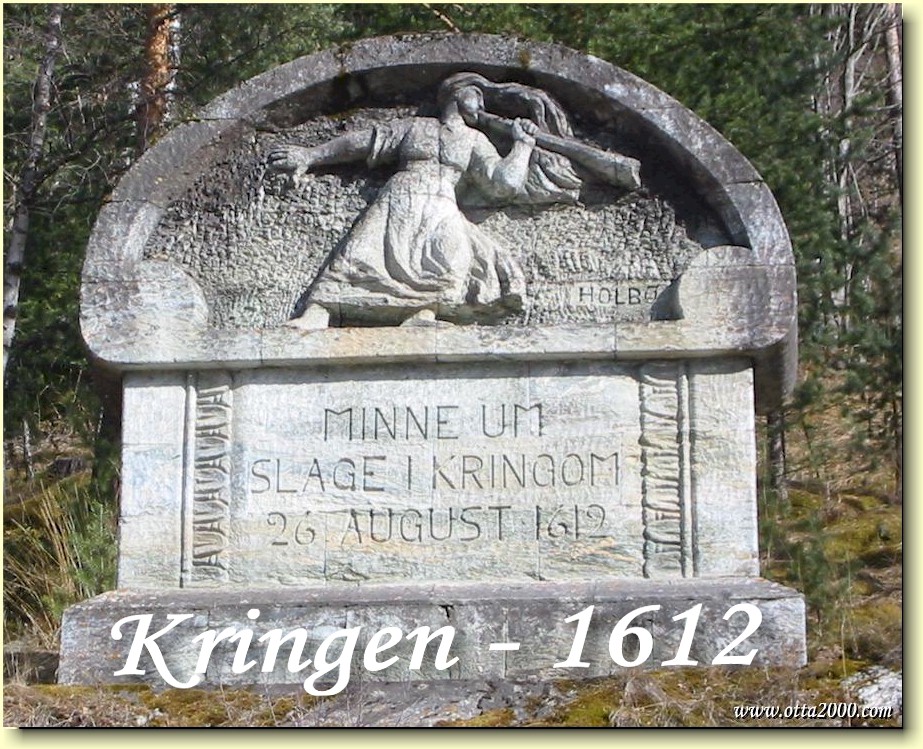 |
| |
|
|
| |
 |
Translation
into English by
Norman Henderson |
 |
|
| |
|
|
|
|
| |
Web:
Geir Neverdal (lektor/cand.philol) - Sel Historielag |
|
| |
|
|
|
|
|
|
|
|
|
|
What
significance did this event have
for Norwegian history?
|
| |
|
|
|
Background - The
Battle - Myths?
- Significance - Objects - Literature - Scotland
-
Programme2012 |
| |
|
|
| |
|
|
| |
|
|
| |
Contents of
this page: |
|
| |
|
|
|
| |
The situation before and during the Kalmar War
1611-13
Fear for one’s own life, farm and property
After the Kalmar War - greater self-confidence and
belief in one's own capabilities?
1808 - Christian August asks his Brigade Generals to
learn from the battle at "Kringelen"
|
300th. Anniversary in 1912
Aftenposten - August 1912
Access forbidden for traffic through Kringen and
problems with overnight stays
From Kong Haakon VII’s speech at the Dinner
District school Headmaster Stokkeland and the
historic Procession in 1912
Gudbrandsdølen
350th. Anniversary in 1962
|
|
| |
|
|
| |
|
|
| |
The situation before and during the Kalmar War 1611-13 |
|
| |
The farmer soldiers often refused to fight.
During the Nordic Seven Years War, 1563-70, the farmers
on both sides of the border made peace with each other,
according to Alnes (p.238). They entered into
“farmerpeaces” with the opposing troops. They committed
themselves to serving a new King loyally, but only if he
respected their old laws and left them in peace.
Trøndelag is easily conquered in 1564
When the
Swedish troops invaded Trøndelag in the winter of 1564,
they met little resistance. “The resistance which the
authorities in Trondheim could organize was quickly
defeated by the Swedish troops. The populace in general
quickly accepted the Swedish King as their sovereign.
The result of the Swedish invasion was so positive that
a large number of troops were demobilized and sent home
again to Sweden. At the same time, plans were made for a
further conquest Southwards along the coastal region in
the West”.
"Forsvaret
fra Leidang til totalforsvar" (*Defence from
Leidang
to total defence”) by Ersland, Bjørlo, Eriksen and
Moland).
The Kalmar War 1611-1613 - Norwegian farmer soldiers
desert
When
Christian lV gave the order in 1611 for the mobilization
of 6000 Norwegian men, who were to be sent to fight on
the Swedish border, no more than 2000 could be gathered
near Svinesund - and they refused to march across the
border into Sweden. The soldiers deserted and by October
there were no more than 200 left in the camp.
Kringen is the exception
In this
situation it is Kringen which stands out as being
unusual.
While the mercenaries who chose to take the route
through Trøndelag to get to Sweden did so almost
unhindered, those who marched through Romsdalen and
Gudbrandsdalen were stopped at Kringen
Fear for one’s own life, farm and property
It is however less believable that this was due
to any desire to serve the King in Copenhagen.
It is much more likely that fear for one’s own
life, farm and property was the reason behind
the farmers’ total commitment in this
situation.That so many as 4-500 men able to bear
arms, out of a local population of some 3000
men, women and children, were able to gather at
Kringen in time to meet the invaders, organize
themselves and carry out an action of which they
had absolutely no previous experience and under
such extreme pressure because of lack of time -
indicates that this was seen as a “be or not to
be” situation by them.
Lonbakken points out another important
fact: The leaders - i.e. Sheriffs Hågå and
Randklev, must have been very highly respected
in the farming communities. It is significant
that it was they, and not the Bailiff, who lead
the resistance at Kringen.
|
|
| |
|
|
| |
|
|
| |
After the Kalmar War - greater confidence and belief in
one’s own capabilities?
The praise which the dalesmen received after this must
have contributed to giving them greater self confidence
and strengthened their will to defend themselves - and
their ability to do so. |
|
| |
The reaction
was different when Trøndelag became Swedish again in
1658
It seems
significant however, that when
Trøndelag (the whole of Trondheim’s fief in addition
to Nordmøre and Romsdal) was taken by the Swedes some 40
years later, the will to fight, and morale, were
completely different.
Alnes writes: “The farmers in Østerdalen and
Gudbrandsdalen gathered voluntarily, under their old
banners to retake Trøndelag” (p.241).
Together with newly trained farmer soldiers from
Hordaland and Sogn, they quickly recaptured the area. |
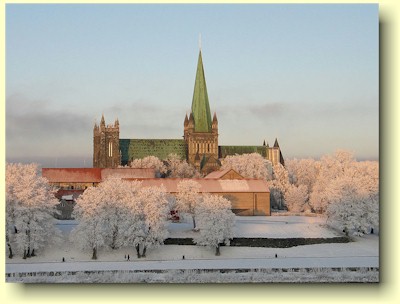
Nidaros Cathedral. Photo:
Morten Dreier (Wikipedia) |
|
| |
|
|
| |
Ivar Teigum
relates in the book "Bygdebok for Vågå og Sel"
(“District Records book for Vågå and Sel”)
that in Gudbrandsdalen Bailiff Jørgen Filipsen mobilized
“500 men who, at their own cost and under local banners,
went to help drive out the Swedes again from the
neighbouring fiefs in the North and West, under the
command of the farmer Captains Kristen Nilsson from
Gausdal and Hans Tolstad from Vågå....
A company of
Dragoons from Gudbrandsdalen also took part in the
campaign. This unit of mounted farmer soldiers was
stationed at Oppdal”. (Teigum 2 p. 67).
In December 1658 the Swedish Commander Stjernsköld and
his troops in Trondheim capitulated.
During the siege of Trondheim the dalesmen from Northern
Gudbrandsdalen had had the responsibility for Guard Duty
and Hans Tolstad was honoured with the exemption of tax
on his farm for several years in recognition of his
service.
In the southern part of Norway the war continued until
the Spring of 1660. Dalesman from Gudbrandsdalen are to
be found in both Kristiania and Fredrikstad. (Teigum 2
p.67). |
|
| |
(Teigum 2 s.
67) |
|
| |
|
|
| |
Ved
freden i København 27. mai 1660 ble Trondheims len,
Nordmøre og Romsdal gitt tilbake til Norge, |
|
| |
See also
Verdalsbilder (Norwegian text) |
|
| |
|
|
| |
|
|
| |
1808 - Christian
August asks his Brigade Generals to learn from the
battle at “Kringelen”
|
|
| |
Angell
refers to the Danish/Norwegian General (and Governor)
Christian August (he later became the Swedish(!)
Crown Prince, called Karl August, but died early, in
1810).
Knut Mykland gives the following information about
Christian August: |
|
| |
|
|
| |
“When
Denmark/Norway became involved in the war with Great
Britain in 1807, the King decided to establish an
interim governing commission in Norway which “on its own
responsibility” was given the task “to decide everything
which was necessary to the Country’s Best - when there
was no time to obtain a special Royal Resolution”.
It was a foregone conclusion that Christian August
should be the Presiding Officer. This reflected his
princely manner and military rank, but in no way his
wishes. Just a few hours after he had received the Royal
Resolution of the 24th. August, he wrote to the Crown
Prince asking that General von Krogh in Trondheim should
be Presiding Officer. The Prince’s attitude wasn’t only
dictated by
military considerations, it was also an indication of
his lack of self confidence. Christian August was not
exceptionally gifted. But he exhibited drive in carrying
out an order, and in areas where he felt comfortable,
“showed strength and ability to act”.
SNL (Norwegian text)
According to
the Store norske Encylopedia the war with Great Britain,
and from 1808, the war with Sweden, presented Christian
August with serious problems: |
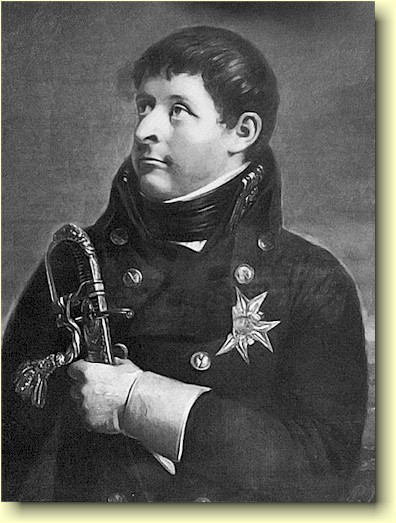
Christian August (senere svensk kronprins Karl
August)
1768-1810
Wikipedia |
|
| |
On the one
hand he had to fight against an enemy from the East,
while at the same time being faced with enormous supply
problems.
During the campaign of 1808 he won major battles against
the Swedes at Toverud and Prestebakke, and a large
number of Swedish soldiers were taken prisoner. The
superior Swedish force was driven back and after the
summer of 1808 no Swedish soldier set foot on Norwegian
soil again.
Angell
writes about him (p.55):
“....at the start of hostilities on the Swedish
border in 1808 (Christian August) recommends his
Brigade Generals the battle of “Kringelen”.
continuation “....he wanted to encourage us by
taking an example from our own history of warfare.
As the best he points out to us the Battle of
Kringelen. ”In narrow places ways in and ways out
must be made impossible” he says; “remember
Kringelen...”
|
|
| |
|
|
| |
|
|
| |
A rich
selection of word of mouth tales/myths/legends?
connected to
The Scottish March and the Battle of Kringen
Some of
these myths/sagas/legends? are addressed elsewhere in
this presentation.
- But the
very fact that there is such a rich selection of word of
mouth tales/myths/legends? connected to The Scottish
March and the Battle of Kringen - expresses something of
the importance of the event to the awareness and self
esteem of Norwegians afterwards. |
|
| |
|
|
| |
|
|
| |
|
|
| |
The story of Pillarguri and her part in the
battle at Kringen has, as has been related
earlier, made a strong impression on very many
people - and she is one of few figures in our
history known to the majority of Norwegians and
to whom they relate.
She was also one of several symbolic figures at
the time of the dissolution of the Union with
Sweden in 1905.
|
|
| |
|
|
| |
|
|
|
| |
|
|
|
|
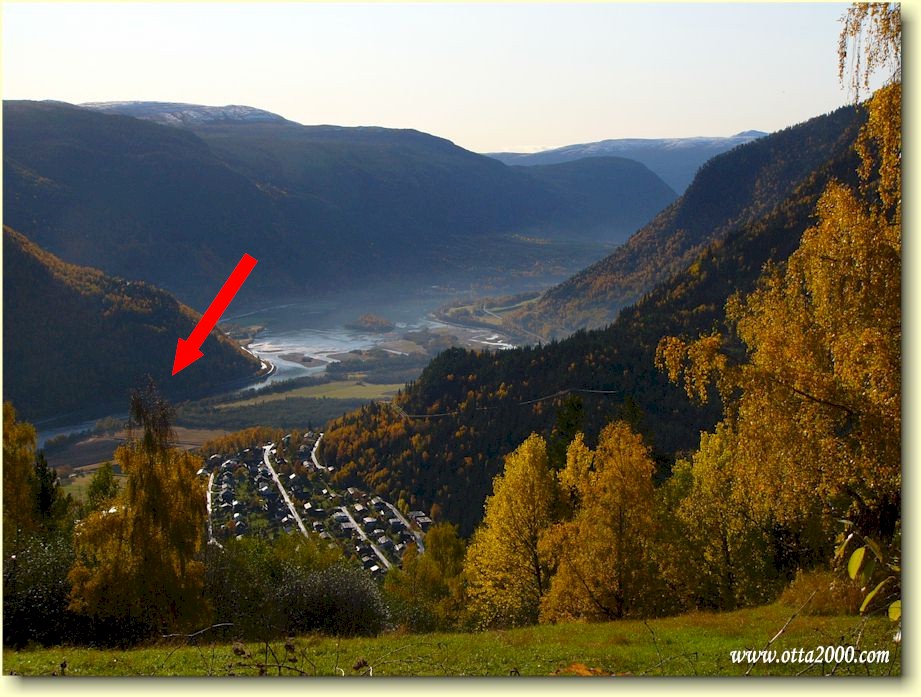 |
| |
|
|
| |
|
|
| |
|
|
| |
|
|
| |
|
|
| |
The 300th.
Anniversary in 1912 |
|
| |
|
|
| |
|
|
| |
Norwegian immigrants in the USA - A new Monument at
Kringen.
|
|
| |
It was not
by chance that, when in 1906-one year after Norway once
again became a sovereign state, 83 immigrant dalesmen
from Gudbrandsdal gathered together to found a society
that one of the first projects was to collect funds for
the erection of a new monument at Kringen.
The symbol which was later chosen was precisely that of
the Pillarguri figure.
Kristen Holbø created the new Monument, which was paid
for by the collected funds, and erected at Kringen in
1912.
Nor was it
by chance that it was
King Haakon who performed the unveiling of
the monument at the 300th Anniversary at Kringen in
1912. The Prime Minister and several
Members of Parliament were also present - together with
some 8000 spectators.
(The numbers
taken from Pål Kluften’s newspaper article covering the
event in 1912). |
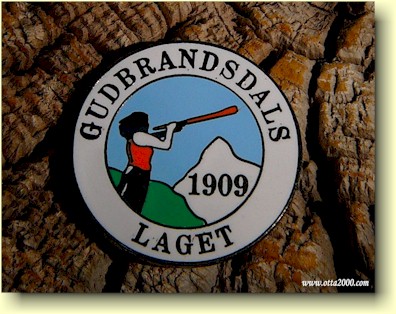
The members of
Gudbrandsdalslaget in the USA
collected funds for the erection of the new monument
at Kringen in 1912. |
|
| |
|
|
| |
Choice of
subject |
|
| |
|
|
|
| |
Ivar Teigum
writes more about this in volume four of the "Bygdebok for Vågå og
Sel" (District
Records book from Vågå and Sel):
“In accordance with his
(Kristen
Holbø’s)
suggestion the legendary figure of Pillarguri was
chosen as the subject for the stone, which was to be
a soapstone block from Tolstadåsen. The block was
delivered and the subject carved out by the sculptor
Ola Nyseter”.
(p.68)
Kristen Holbø’s choice of Pillarguri as the
subject for the Kringen Monument in 1912 was well
received at that time. The same was to be said for
the actual design and execution. The relief showing
the girl with the
"lur"
(horn) was interpreted romantically. The event in
1612 was regarded as a bright light in an otherwise
dark period for the nation in the 1600s”
(p.71)
|
|
| |
|
|
|
| |
Lars P.
Thorkveen (1857-1923)
When the
first Society for immigrant dalesmen from Gudbrandsdalen
was founded in 1906, the 83 founders chose the name
“Kringen” - and the first project of the new
organization, as has been said, was to collect money for
a Monument (the Holbø Monument) at Kringen in Sel. This
was to be ready for the 300th. Anniversary in 1912.
On the 12th September 1909 the Gudbrandsdalslaget
Society was founded in Minneapolis with the same
objective and Pastor Lars P. Thorkveen from Lom was
voted as the first President, an office he held until
his death in 1923.
In 1912
Thorkveen, together with 29(?)
other members of the
Society, travelled to the 300th Anniversary celebrations
to witness the unveiling of the Monument by King Haakon Vll.
(Årbok for
Gudbrandsdalen 1982 p.108)
NB There
is now doubt as to the correctness of this number:
Jim Olson (former President of Gudbrandsdalslaget)
has found evidence which strongly suggests that the
article in the 1982-årbok (yearbook) is incorrect -
and that just Thorkveen and a couple of other
members of Gudbrandsdalslaget were present in
Kringen in 1912.
We will get to know more about this at the
History Seminar on
August 23. 2012.
(G.N.
June, 23. 2012)
|
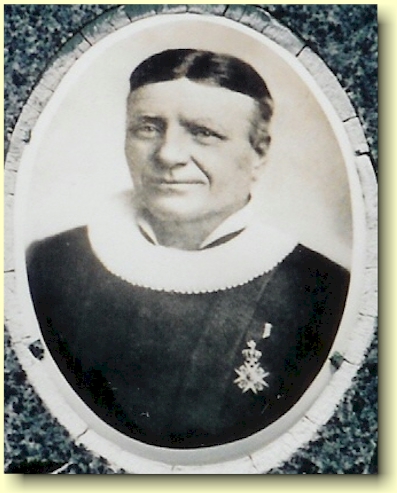
The photo of Thorkveen in his clergy robe with
his award is
taken from his tombstone in the Albion Church Cemetery.
Our thanks to Jim Olson and the Gudbrandsdalslaget
Society in the USA
for the loan of this photograph.
The picture
shows Thorkveen in his clergy robe, and
the St. Olav medal he was awarded for his work. |
|
| |
|
|
|
| |
We have an
article of nearly nine pages in length where he
describes the event in 1912. |
|
| |
|
|
|
| |
|
|
| |
Aftenposten - August
1912 |
|
| |
|
|
| |
In the
second half of August
Aftenposten covered the 300th. Anniversary
celebrations for several days with large first page
articles and many photographs.The King and Prime
Minister came by special train to Otta.
Aftenposten
writes further:
“Large numbers of people came today both by vehicle
and on foot; but the majority have come on the extra
trains.
Miltary
units and the 2nd. Brigade’s Military Band also arrived
by extra train. They made camp at “Loftsgårdsøya” just
North of the railway station.
In 1912 Otta was the terminus of the railway
line from Oslo - and the automobile was still in
its relative infancy, so that horseback was the
most normal means of transport for those who
didn’t walk.
|
|
| |
|
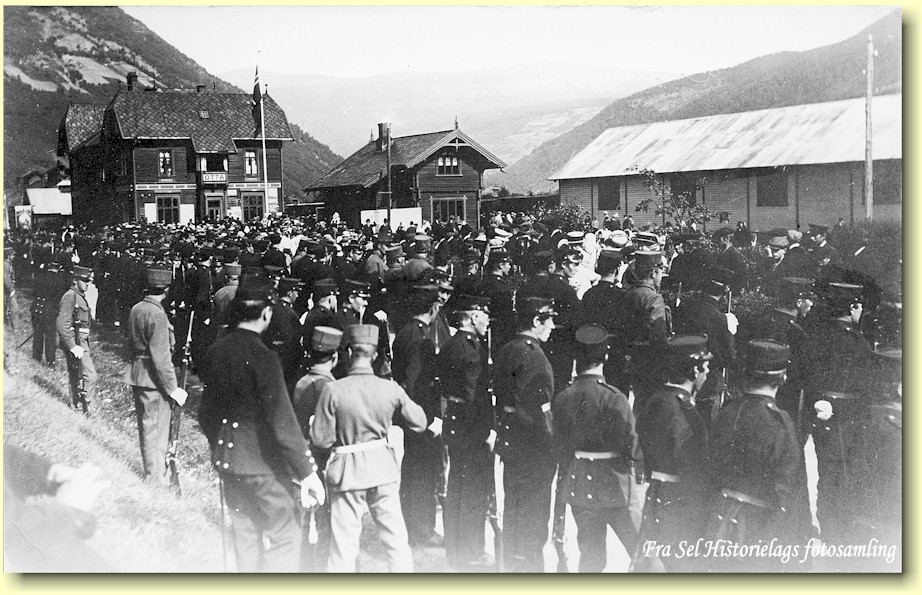
Otta Station 26th. August 1912
(Photograph acquired by Stig Pettersen) |
| |
| |
Access
forbidden for traffic through Kringen and problems with
overnight stays in 1912
It was
found necessary to close the road through Kringen for
all traffic that day, whether it be horse drawn, on
horse back or automobile traffic.
The
general order which only permitted “automobile” traffic
on the main road (today’s E6) between Sel (Laurgaard)
and Otta in accordance with a timetable, was temporarily
rescinded - in consideration for those who stayed
overnight - so that in the period Monday 26th. to
Tuesday 27th. August, this stretch of road could be
driven at any time.
It was
also pointed out that
from the
25th. until the 27th. August one should always be aware
that “automobile” traffic could possibly be met on the
main road between Otta and Vinstra.
Horses
(and their riders) were not used to cars at that time. |
|
| |
|
|
|
| |
Kringendagen.
In order to avoid danger it is hereby declared, that
it shall be forbidden for automobiles, horse
drawn vehicles and riders to use the main road in
Sel from South Kringen to 500 metres South of the
Kringen Monument from 12 Noon until 2 p.m. Monday
26th. August 1912.
Attention is therefore drawn to the fact that, in
consideration for those staying overnight, it is
also permitted to drive with an automobile on the
main road between Laurgaard and Otta outwith
the stipulated times of the timetable, from 2
p.m. Monday 26th. August until 2 p.m. Tuesday 27th.
August 1912. On the main road between Otta and
Vinstra other drivers must always be aware that
they could meet automobiles during the period 25th.
to the 27th.
Kristians district the 21st. August 1912.
Joh. A. Svendsen
bem.
|
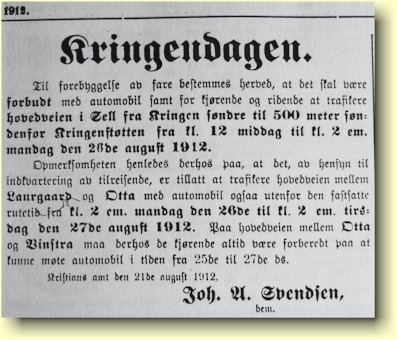 |
|
| |
It was
impossible to find accommodation. All the hotels and
private homes were more than full - and many had to find
lodgings some considerable distance away.
Pål
Kluften tells that it was necessary to travel
30
kilometres to the south to find lodgings for the night
before the 26th. August. |
|
| |
|
|
| |
|
|
| |
|
|
| |
From
Aftenposten’s morning edition the 27th. August 1912: |
|
| |
|
|
|
| |
|
|
| |
Unveiling of the Kringen Monument
A splendid
occasion full of atmosphere
Special telegram to “Aftenposten”. |
|
| |
|
|
|
| |
Otta 26th. August |
|
|
| |
The Kringen
celebrations commenced this forenoon under the most
fortunate conditions.
This is so much more pleasant than the weather yesterday, which was
far from the best. About 6 o’clock yesterday
afternoon the rain began to pour down and continued
far into the night. The Anniversary Committee were
in despair as were the many who had made the journey
here. It looked hopeless.
When the train carrying the 2nd. Brigade’s Non-commissioned
Officers School and the 2nd. Brigade’s Military Band
arrived at the station yesterday evening it was
raining “cat and dogs”. It was no better when the
train carrying the 11th. Company arrived half an
hour later. The rain was beyond description and many
were heartily sorry for the Non-commissioned Officer
pupils and the soldiers who were to camp outside in
tents. Both units made camp on Loftgaardsøen some
way beyond Otta Station.
Many people came yesterday. All the hotels and private homes are
full to capacity and many had to look for
accommodation further away in the district.
All the flags are hoisted today and many houses are beautifully
decorated. There is an atmosphere of celebration in
the air. Both yesterday and today scores of people
have been seen on the two kilometre long road to the
Kringen Monument. The Royal platform has been
erected just down from the Monument and flags have
be placed all around. Large numbers of people have
arrived today both on foot and by other means of
transport; but the majority have come on the extra
trains. How many people are present is difficult to
say, but they can surely be counted in the
thousands.
The Royal Train
rolled into the station at 11.30
this forenoon. The platform was packed with people.
Everyone pressed forward eagerly to get a glimpse of
the King, who was greeted with rousing cheers. The
King was received by County Administrator Lambrechts
and the Anniversary Committee led by book seller
Narvesen. From the station to the Grand Hotel,
where the King is staying, soldiers lined both sides
of the road.The Band of the 2nd. Brigade played.
A quarter of an hour
after the Royal Train’s arrival the Anniversary
procession moved off with the Band of the 2nd.
Brigade at the head. The 11th. Company followed,
then the King, invited guests and the Anniversary
Committee. Then came the “Dalesmens” procession with
Magnus Barfod’s banner in the lead, the riflemen,
the schools and finally the members of the public in
procession. When the Anniversary procession reached
its destination, the 2nd. Brigade’s Non-
commissioned Officers School was already formed up
there.
The unveiling
ceremony
commenced with the singing of the
national anthem, “Ja vi elsker”, after which the
Kringen Committee chairman, Johan Nygaard wished
everyone welcome. The musicians then played "Fortællingen
om skotterne" (“The tale of the Scots”), a legend
based on the Pillarguri folk melody and the Scottish
March by O. Hjellemo, who also conducted the music.
The music was greatly enjoyed.
After that Colonel Angell held the Anniversary speech, from which
we quote:
Your Majesty, men and women of Norway!It was 300
years ago today. A tone from the lure was heard from
the Pillarguri peak. Then a landslide started up
there on Høgkringenaasen. It was only a young girl
who blew the lure. It was only a small force
of farmers who charged down a hill. But that lure
had tones, just like the old battle lure, when it
rallied to battle and the
farmerhorde advanced as they had always done, with
sharp axes in strong hands. It resounded from
mountain to mountain, and the echo from village to
village and throughout the land of Norway. It has
been a long time now since we heard the Norwegian
battle lure and seen Norwegian farmers go forward
into manly fight;
(continues up to the right)
|
but we had waited a long time
for the tones to call us. It was the longing of the
Norwegian people. It was therefore something greater
which was set in motion by the tone of the lure on
the 26th. August 1612 , than the small avalanche
created by the farmers. It was the rebirth of the
Norwegian people. Therefore the girl will come to
stand firm in our peoples’ thoughts as an image of
the beacon watch from high peaks, and the farmers’
landslide as the rebirth of our old, strong national
defence. The beacons had long been without watchers.
Therefore they had also deteriorated and our
national defence was in decline. These were dark
times.
That, which first and foremost gathers us together today, is
therefore not only the memory of the Norwegian
farmers’ fight, and about the victory of the men of
Gudbrandsdalen at Kringen, but it is also about the
rebuilding of the peoples’ army, the reminder that
the nation is more important than the village. This
is exactly what makes this day belong not only to
the people of Gudbrandsdalen, but also to Norway.
The speaker then continued to give a detailed
description of The Scottish March, the Colonel ended
in this way:
Here in Kringen - 300 years after the Battle -
Norwegian men and women have come to honour the
memory of those who fought, gave their lives, stood
guard at the beacons, and by carrying out brave
deeds, set an example for everyone. We meet at this
Monument, which one of the valley’s sons has
created. We know that the artist will, in this way,
tell us about the duty, which everyone has, when the
beacon guard blows the lure, calling to battle.
The Pillar-Guri-lure roused the people of Norway’s
valleys, made them look beyond the confining borders
of their villages, rallied them to fight and win,
roused them so, to fever pitch --
After the speech a song composed
by the school teacher
Hans Nyhus was sung to the melody "Mens
Nordhavet bruser" (“While the North Sea rages”).
Three verses are quoted here:
And the dalesmen fought a
summer’s day
at Kringen below the slope (to the river),
for their home and valley they fought a fight,
which shall be remembered in time to come.
When the tone of the lure sounded from the
mountain,
came the ”avalanche” from above and Berdon fired
his gun
From Ringebu in the South and to Lesje and Lom,
they went to the bloody meeting,
to protect their fathers’ land they came
and used their strength and abilities.
When the sun went down, and so it was night,
for the March of the Scots, the end of their
might.
Three hundred years have gone by,
and light and shadow have changed,
but in the valleys there are still women and men
who will build “avalanches” against attackers.
When the battle lure calls, we will gladly meet
and forget what otherwise separates (us).
After Angell’s speech Pastor
Thorkveen presented a greeting from the
Gudbrandsdalslaget Society in the USA.
Then Nygaard handed the Monument over to the local
authorities of Sel.
Immediately after the unveiling
The Anniversary
Dinner
commenced. The table was shaped as
a horseshoe and beautifully decorated. The King was
conducted to the table by book seller Narvesen,
Prime Minister Bratlie by Dr. Müller and District
Administrator Lambrechts by Johan Nygaard. Among the
other guests were Members of Parliament Thallaug,
Skoug and Castberg.
Comment: The Anniversary Dinner took place in the
old Solvang building which stood then where Otta
school stands today.
|
|
| |
|
|
| |
|
|
|
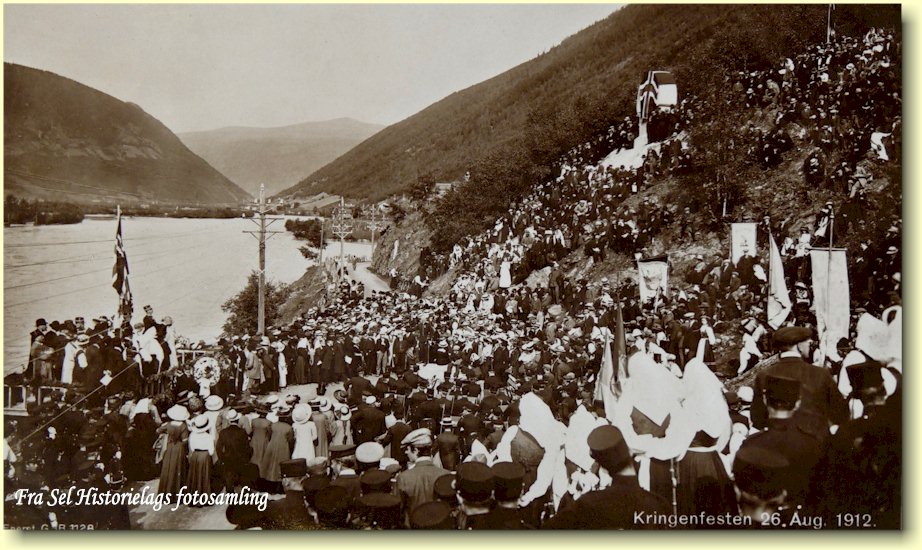 |
| |
From the
unveiling of the new Monument. Colonel Angell
(approximately in the middle of the picture) holds his
speech. The Royal platform to the left in the picture.
The Monument is covered by a Norwegian flag. |
|
| |
(This picture acquired by Stian
Høglien) |
|
| |
|
|
|
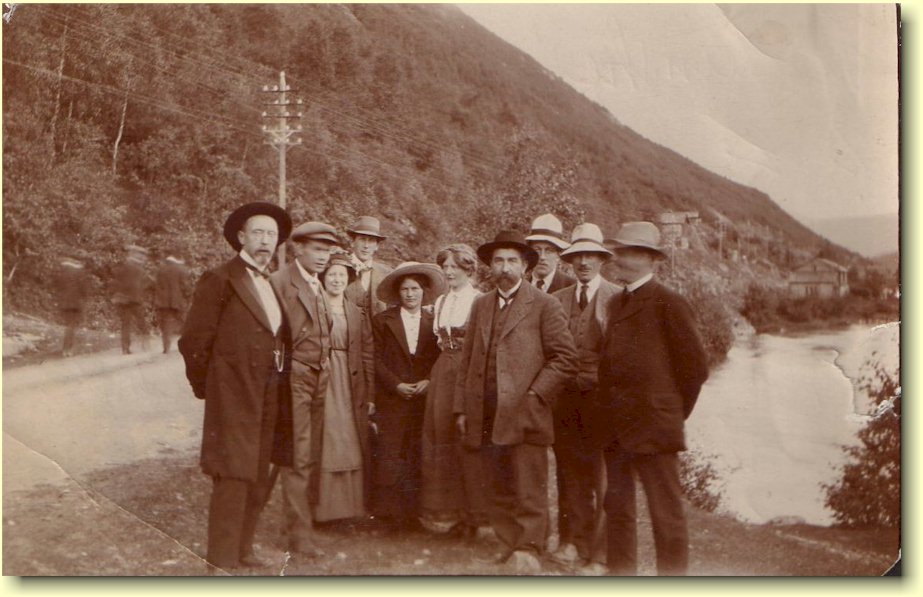 |
|
|
Kristen
Holbø - the sculptor who created the new Monument in
1912
(A
previously unknown photograph from the Anniversary at
Kringen in 1912.) |
|
| |
Bjørn Glad
from Heidal sent this to us in February 2011. It was in
an album of photographs owned by Ragnhild Glad’s aunt -
who was also called Ragnhild. Kristen Holbø is
seen on the left. |
|
| |
|
|
|
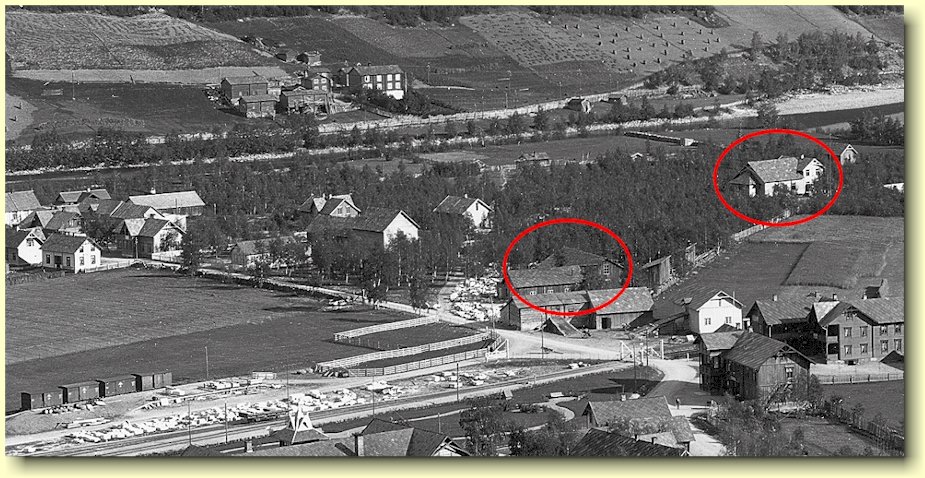
This picture, from 1900 - shows a part of Otta twelve
years before the Anniversary ceremony at Kringen.
Solvang is ringed in on the right, with "Klebersalen"
(the
Soapstone room) to the left.
|
| |
|
|
| |
The
Anniversary Dinner took place in Solvang, Pål Kluften
reports in his newspaper article (August 1912):
“Solvang ... was beautifully decorated. The table
was laid in the form of a double horseshoe. The King
was conducted to the table by book seller
Narvesen”.
The
following could be read in the newspaper
“Gudbrandsdølen” on the 29th. August 1912:
“The ladies of Otta have the credit for the
arrangement of the event in Anniversary Dinner’s
venue, the Chairman of the Anniversary Committee
informs us.
Under Dr. Müller’s sure guidance and after many
days’ effort, the venue was presented, beautifully
decorated with flags and greenery, in good time
before the event. The decorations received many
compliments from the guests”.
Some days
earlier, on the 24th. August, an advertisement in
“Gudbrandsdølen” declared:
“Public celebration at 6 o’clock (Entry tickets
kr.1,-) with the following programme:
Celebration speech by Church singer H. Nyhus.
Music by the 2nd. Brigade’s Military Band.
7 o’clock Dancing in Kleberhallen and Solvang.
9 o’clock Fireworks.
10 o’clock Bonfire on Pillarguri peak.
Both
Kleberhallen (Klebersalen) and Solvang were put to use
that day - and they were certainly needed. According to
Pål Kluften’s notes from the Kringen Anniversary
celebrations about 8000 people were gathered in Otta
that day (others mean there were approximately 5000). |
|
| |
|
|
| |
|
|
| |
|
|
| |
From
King Haakon’s speech at the Anniversary Dinner after the
unveiling in 1912
|
|
| |
|
|
| |
|
|
|
| |
“The King thanked the speaker
for his speech (Bertrand
Narvesen’s speech to the King)
and expressed his pleasure at having been able to
attend the celebrations. What the dalesmen did in
1612 demonstrates that much can be done with small
resources. These people, who did what they did at
that time, with courage and wisdom, achieved
something great. They had little equipment at their
disposal. They had no telegraph or telephone. The
“Budstikka” had to be sent. Many had to make a long
journey to reach their destination. I don’t know if
there was anybody who didn’t come. I think that if
it had been at all possible for them to come, they
would have. Let us therefore hope that there will
always be people here who are ready to defend their
native land. A toast to the Fatherland!”.
The toast was followed by
“three times three cheers”.
(From Aftenposten’s special
telegram the 27th. August 1912)
On the right King Haakon VII in
1906.
Section of a photograph which was to be used as a
postcard (taken by the Norwegian photographer Gustav
Borgen 1865-1926).
Wikipedia
|
 |
|
| |
|
|
| |
|
|
| |
|
|
| |
District School
Headmaster Stokkeland and the historic parade |
|
| |
|
|
| |
Anders
Stokkeland, from 1875 headmaster of the travelling
district school in Gudbrandsdalen for more than 40
years, played a central role in the organization of the
historic procession in 1912. He had also been
responsible for the part Ringebu played in the great
procession when
Maihaugen was opened in 1904.
Because of
his many contacts made during the periods when the
district school was based in North and Central
Gudbrandsdalen, he was the perfect man for the job. He
had also acquired a means of transport five years
earlier- a bicycle - which meant that communication with
the rest of the valley was made easier. (At that time
the alternatives were either walking or horseback).
A bicycle
was very expensive in those days - the equivalent of an
industrial worker’s annual wage.
Bjørnstjerne Bjørnson therefore organized a
collection in 1907 to buy this conveyance for
Stokkeland.
Anders
Stokkeland was also made an Honorary Member of the
Gudbrandsdalen Society in the USA by Lars Thorkveen in
1912 - not only because of his involvement in the
historic procession on this
occasion, but also because many members of the Society
had attended the district school under his leadership
before they emigrated, and they were of the opinion that
his teaching had been a very positive contribution to
their way forward in life.
(Source:
Kristin Øveraas). |
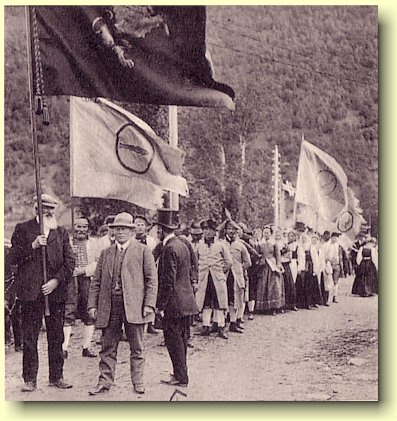
The Dalesmens’ procession forming up.
(Donated by Kristin Øverås)
Grateful thanks go to Kristin
Øverås who has acquired for us copies of
photographs of the Anniversary at Kringen in 1912
from two albums (which are owned today by Hege
Døving) - as well as information about Anders
Stokkeland and Bertrand Narvesen (Narvesen was
Chairman of the Anniversary Committee in 1912).
Kristin has also written a long article about
Stokkeland in the Ringebu Historical Society’s book
“Hemgrenda 2009”.
|
|
| |
The bicycle is still in existence, described as
“Bjørnsonsykkelen” - in the Romsdal Museum - and has the
following inscription on the front:
A.
Stokkeland
fra
Bjørnstj. Bjørnson
A.
Stokkeland
from
Bjørnst. Bjørnson
|
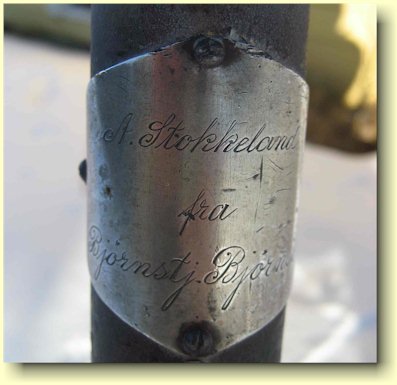
Foto: Astrid Øverås |
|
| |
|
|
| |
Gudbrandsdølen |
|
| |
|
|
|
| |
(coming later) |
|
|
| |
|
|
|
| |
|
|
|
| |
|
|
|
| |
|
|
|
| |
|
|
|
| |
|
|
|
| |
|
|
|
| |
|
|
|
| |
|
|
|
| |
|
|
|
| |
|
|
|
| |
The
symbolic value has been - and is
significant. |
|
|
| |
|
|
|
| |
|
|
|
| |
|
|
|
| |
|
|
| |
The 350th. Anniversary in 1962: |
|
| |
|
|
| |
|
|
| |
|
|
| |
The 350th.
Anniversary at Kringen in 1962: |
|
| |
(More information will come later) |
|
| |
|
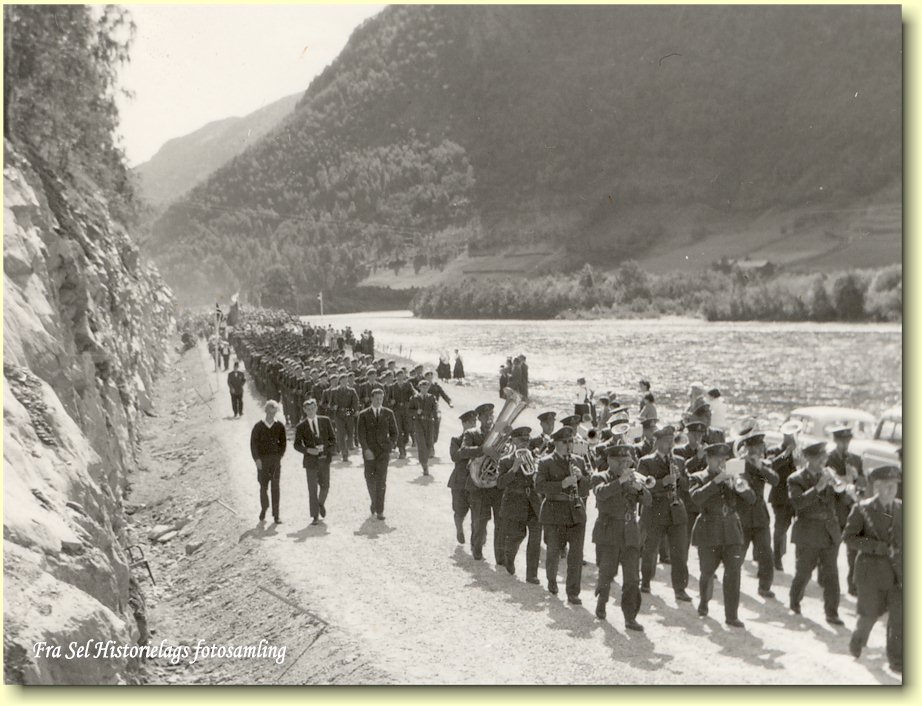 |
| |
(Sel Historical Society has
been given these photographs by Ola Blekastad) |
|
| |
|
|
|
|
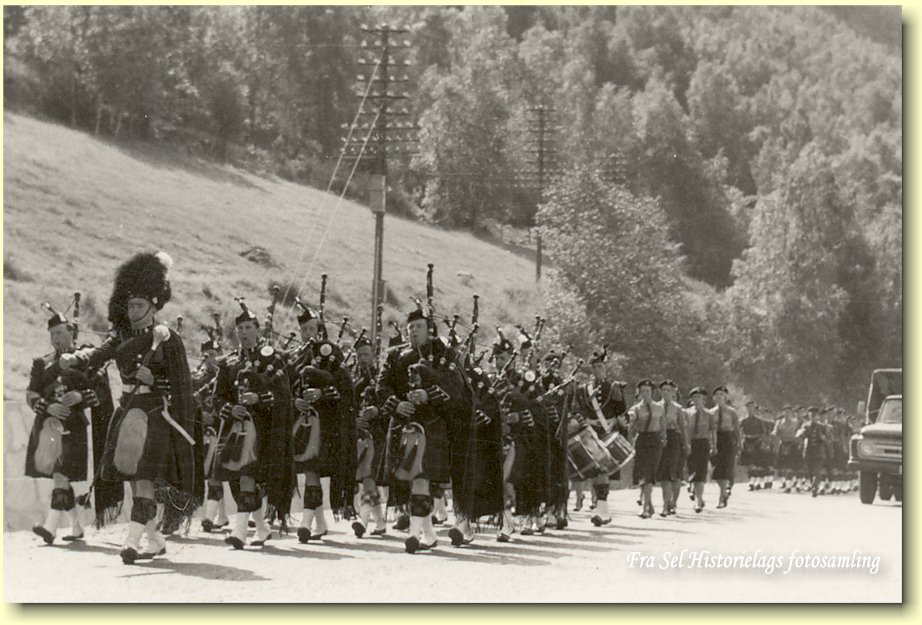
This picture is most probably from the visit by the
Scots the year after - in 1963.
|
| |
|
|
|
| |
|
|
|
| |
|
|
| |
Programme
for the Kringen Jubilee
26th. August 1962
Saturday 25th. August.
|
|
| |
|
Kl
18.00 |
Parade of the Ministry of Defence,
Eastern District, Military Band |
|
|
| |
|
Kl
19.00 |
Reception in the meeting tent. |
|
|
| |
|
Programme: |
|
|
| |
|
|
Short concert by the Ministry of Defence,
Eastern District, Military Band.
Interview by Syver Plassen about the Kringen Jubilee in
1912.
Olav Snortheim plays the
langeleik and mouth harp.
Otta and Heidal traditional Norwegian Music Performance
Group.
Traditional Norwegian dance by Loar Youth Performance
Group.
Non stop dancing.
Dance music by Tønseth’s seven-man dance orchestra.
Burning beacon on the Pillarguri Peak. |
|
|
| |
|
|
|
|
|
| |
|
|
Entry fee: Adults kr
5.00
Children kr 2.00
|
|
|
| |
|
|
|
|
|
| |
|
Sunday 26th. August |
|
|
| |
|
|
|
|
|
| |
|
Kl 10.30 |
Church Service in the meeting tent
officiated at by Parson Øystein Hovden, Vang. Songs by
the Choir. |
|
|
| |
|
Kl 13.00 |
Procession from Otta to Kringen by the
Military unit, Scots, veterans from 1912 and villagers
from the Northern valley in period costume.
Pillarguri plays the lure from Pillarguri Peak.
Rider riding backwards on a white horse at Storøyen. |
|
|
| |
|
Kl 14.00 |
Commemoration ceremony at the Kringen
Monument.
Opening by the Mayor of Sel kommune O. Dahl.
Music by the Ministry of Defence, Eastern District,
Military Band.
Bagpipe music.
Speech by the Minister of Defence
Gudmund Harlem.
The procession returns to Otta. |
|
|
| |
|
Kl 17.00 |
Brass band and concert band music in Otta. |
|
|
| |
|
Kl 18.00 |
Festivities in the meeting tent. |
|
|
| |
|
|
|
|
|
| |
|
Programme: |
|
|
| |
|
|
Opening by Ivar Øygard, Chairman of the
main Committee.
Music by the Otta Boys Music Group.
Prologue by Gustav Rusten. Song by Gunnar Jordet.
Speech by Member of Parliament
Kjell Bondevik.
Erik Bye and Alf Blyverket entertain during the
festivities in the
meeting tent on Sunday.
Vågå and Lalm Music Performance Group.
Display of “Spring-dance”.
Non stop dancing.
Dance music by Tønseth’s seven-man dance orchestra.
|
|
|
| |
|
|
|
|
|
| |
|
|
Entry fee: Adults kr
5.00
Children kr 2.00 |
|
|
| |
|
|
|
|
|
|
|
|
|
| |
|
|
|
| |
|
|
|
| |
|
|
| |
|
|
| |
|
|
| |
|
|
|
| |
|
|
|
Background - The
Battle - Myths?
- Significance - Objects - Literature - Scotland
-
Programme2012 |
| |
|
|
| |
|
|
| |
Siden ble
sist oppdatert:
25. juni 2012 |
|
| |
Web:
Geir Neverdal (lektor/cand.philol) - Sel Historielag
www.otta2000.com
|
|
| |
|
|
| |
|
|
|
|
|
|
|
|
|
| |
|
|
|
|
|
|
|
|
|
| |
|
|
|
|
|
|
|
|
|